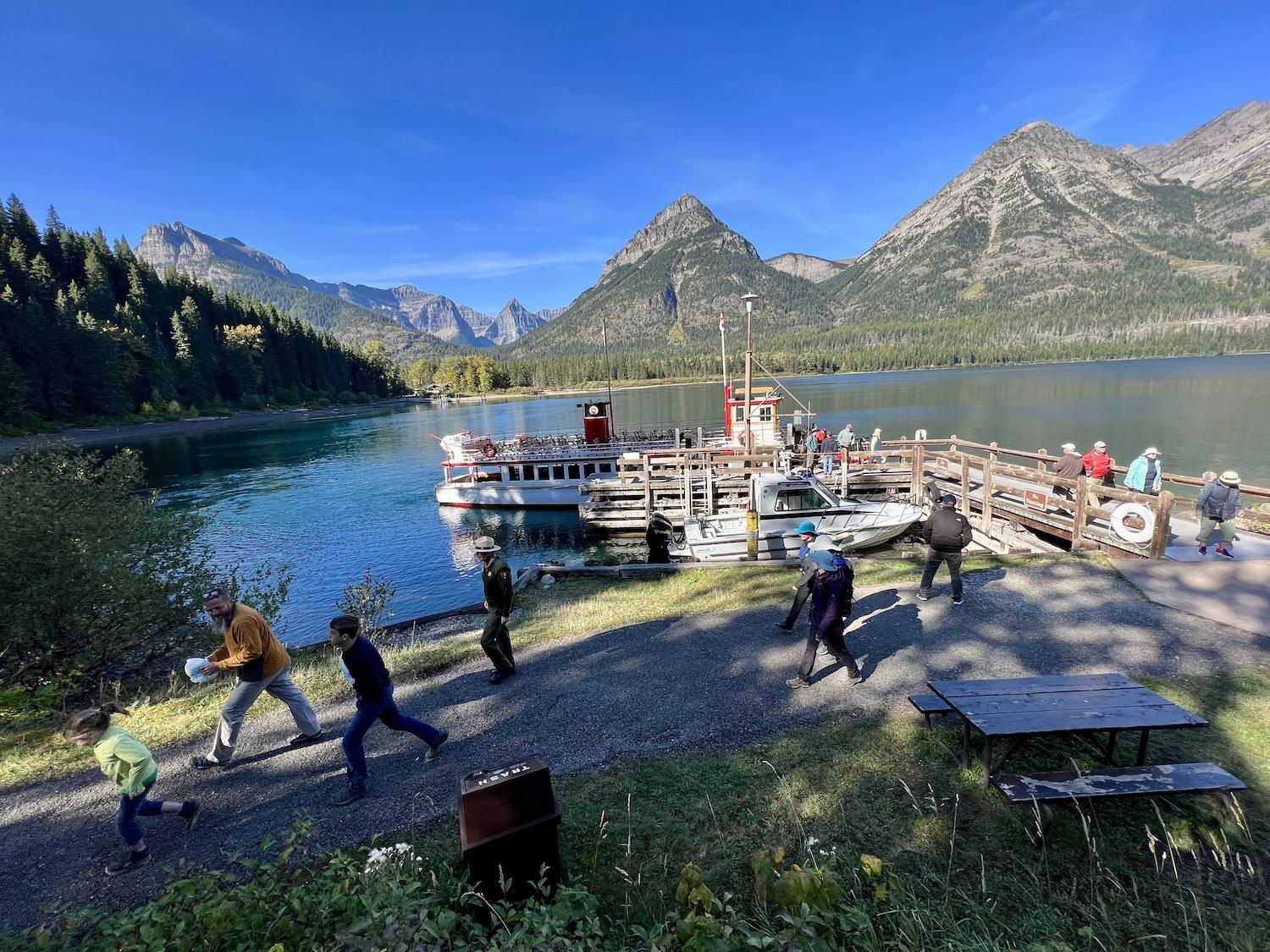
When the M.V. International lands at Goat Haunt in Montana's Glacier National Park, guests have 30 minutes to explore before the boat returns to Alberta's Waterton Lakes National Park/Jennifer Bain
As we cruise over the liquid border from Canada into the United States, the captain of the M.V. International slows down so we can see the hint of two stone boundary markers in a narrow patch of razed forest along Upper Waterton Lake.
This is where Alberta’s Waterton Lakes National Park meets Montana’s Glacier National Park along the world’s longest undefended border.
Sometimes you can take a guided day-long hike between the two countries and do a fun handshake with someone across the border. But I’ve opted for the easier, and more popular, interpretive sightseeing cruise that includes a half-hour stop at the Goat Haunt ranger station on the U.S. side of the lake.
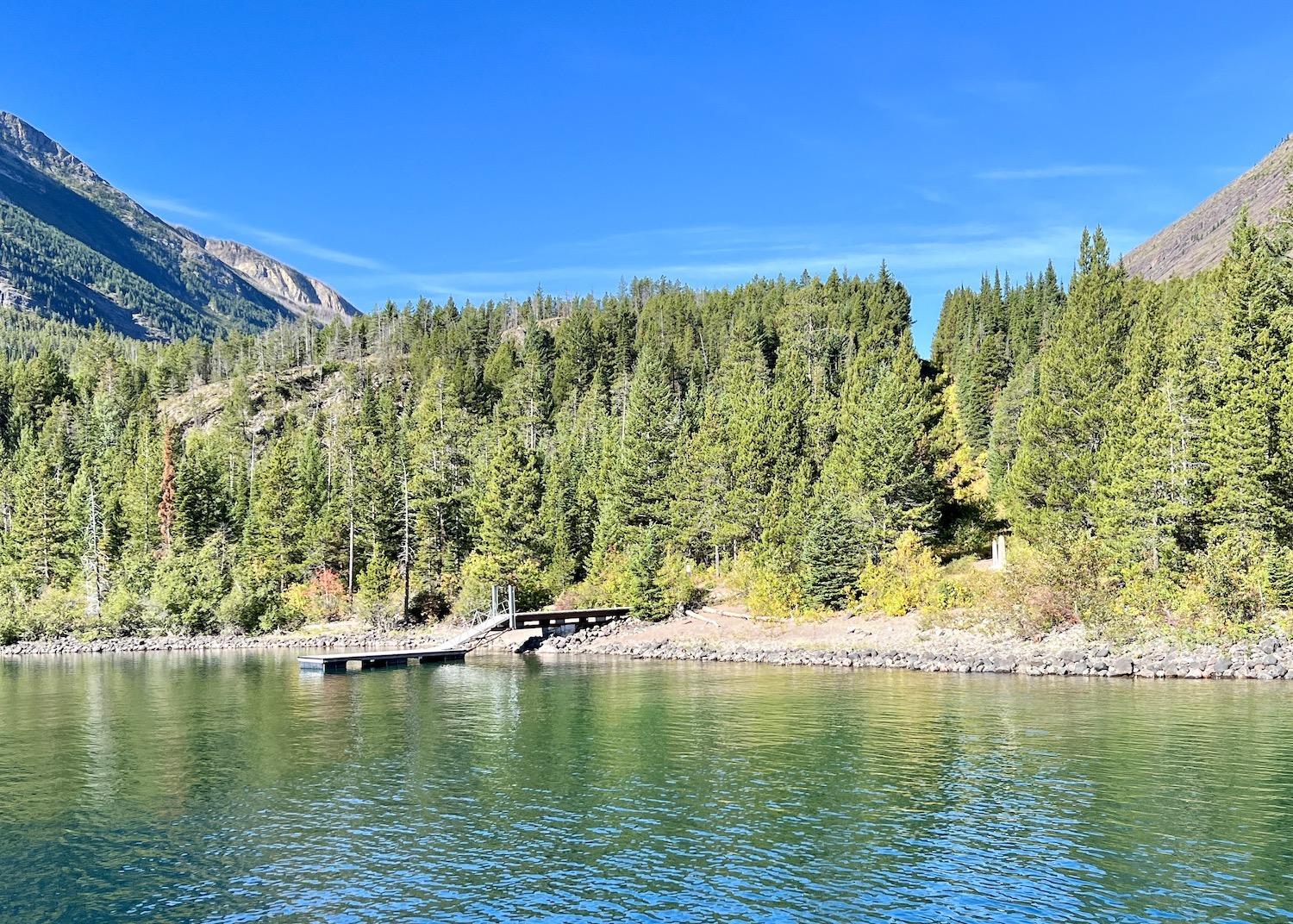
A view of the land border between Alberta's Waterton Lakes National Park and Montana's Glacier National Park and the international boundary markers/Jennifer Bain
We don’t need passports and don’t have to register on the U.S. Customs and Border Protection app like the hikers do. Instead, National Park Service ranger Frank Jahn comes aboard to invite us to follow a paved pathway to the Snowflake Pavilion for a quick talk.
“You have landed in a very unique place,” Jahn tells us. “Perhaps the most unique thing about this area is that right now you are in what became the very first international peace park on our planet.”
Indeed, I’m here to discover exactly what the Waterton-Glacier International Peace Park is. I mistakenly thought it was a small, physical area straddling the border that separates two parks and two countries. Now I realize it’s actually just a designation — meaningful, yes, but intangible and harder to grasp.
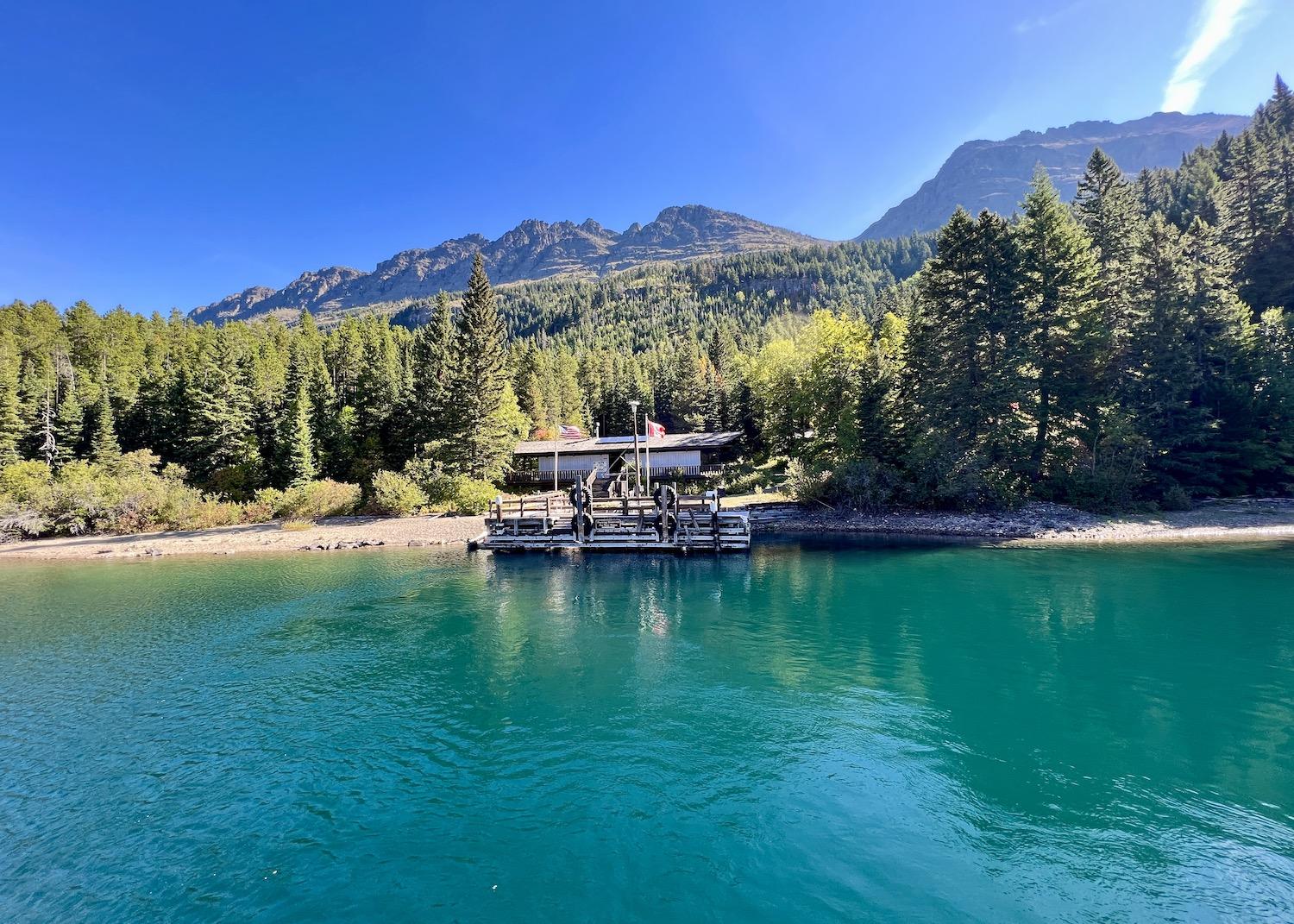
The M.V. International lands at this modest wilderness dock in Glacier National Park by the Goat Haunt Peace Pavilion/Jennifer Bain
Waterton was established in 1895, Glacier in 1910.
In the early 1930s, I read at the Goat Haunt Peace Pavilion, “the world was wrapped in the stifling blanket of depression, famine and anguish left by the Great War. A group of optimistic citizens along the international boundary between Alberta and Montana found a way to shine a beacon of light into all this darkness.”
Members of Rotary International, from clubs both north and south of the 49th parallel, decided to celebrate the peace, friendship and cooperation between the two countries. They held their first annual goodwill meeting July 4, 1931 at the storied Prince of Wales Hotel that was built in Waterton by the Minnesota-based Great Northern Railway. They unanimously passed a resolution to establish an international peace park and immediately started lobbying their respective governments.
It didn't take long. The next year, the U.S. Congress and Canadian Parliament each created legislation establishing the Waterton-Glacier International Peace Park. U.S. President Herbert Hoover was “gratified by the hope and faith it will forever be an appropriate symbol of permanent peace and friendship.” Canadian Prime Minister Richard (R.B.) Bennett hoped the park would “forever remain a permanent memorial of all that neighbourly relations should be between adjoining nations.”
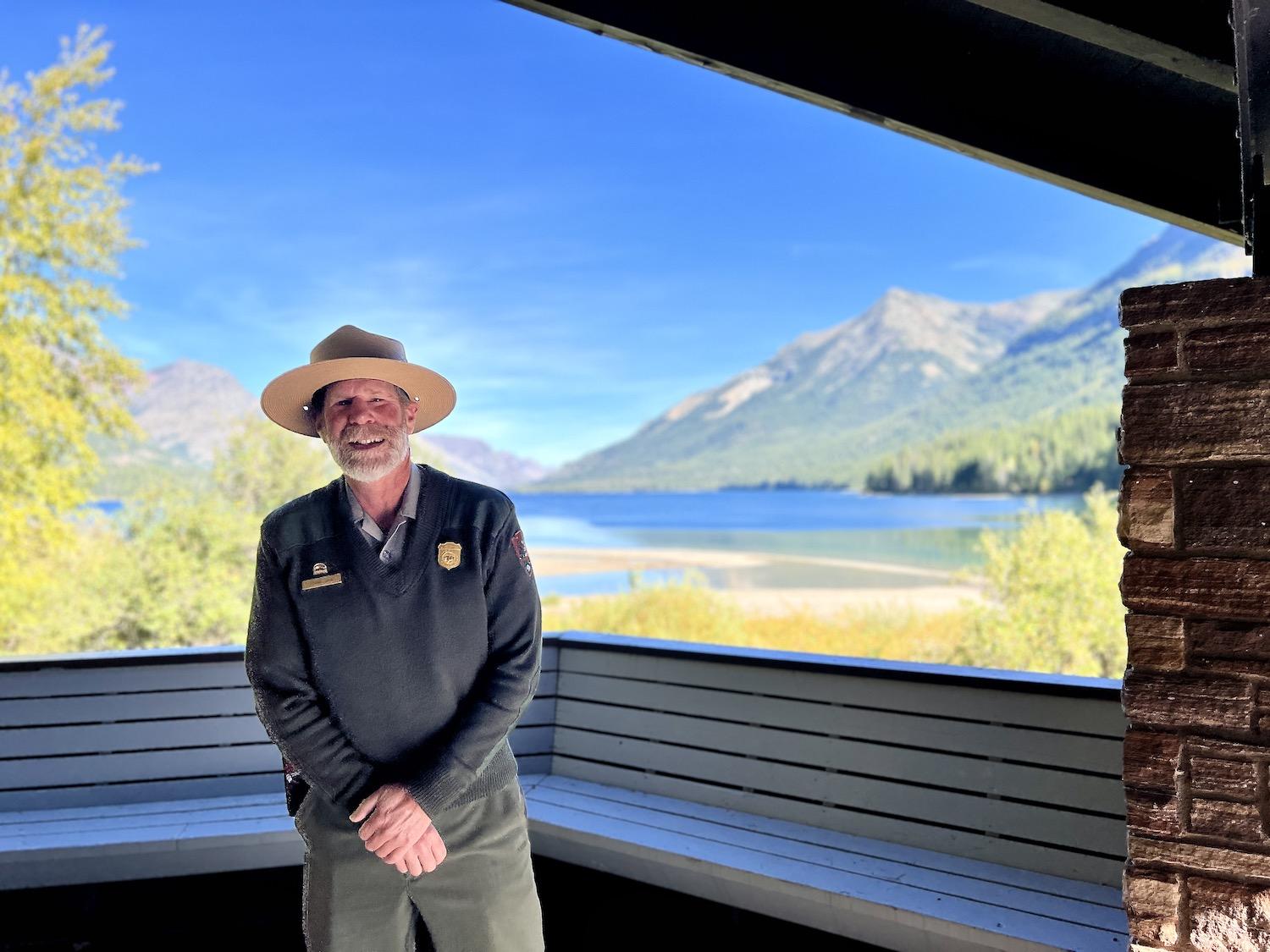
Glacier National Park interpretive ranger Frank Jahn stands in the Snowflake Pavilion at Goat Haunt in front of a landscape so beautiful that it looks like a painting/Jennifer Bain
Jahn pulls out a laminated passage from the legislation and reads it to us.
“There is no area in America more replete with beauty of the highest order than that comprised within these two national parks. Tremendous mountains with carved cirques in which the snows and glaciers of countless ages are encompassed, innumerable lakes, each a gem of its kind, canyons of that character described by Robert Service when he speaks of `canyons plumb full of hush;’ these are the describable features of this region.”
“But,” Jahn continues, “it has about it something indescribable. Perhaps the imminent presence which broods over it and which is universally felt may best be described as peace.”
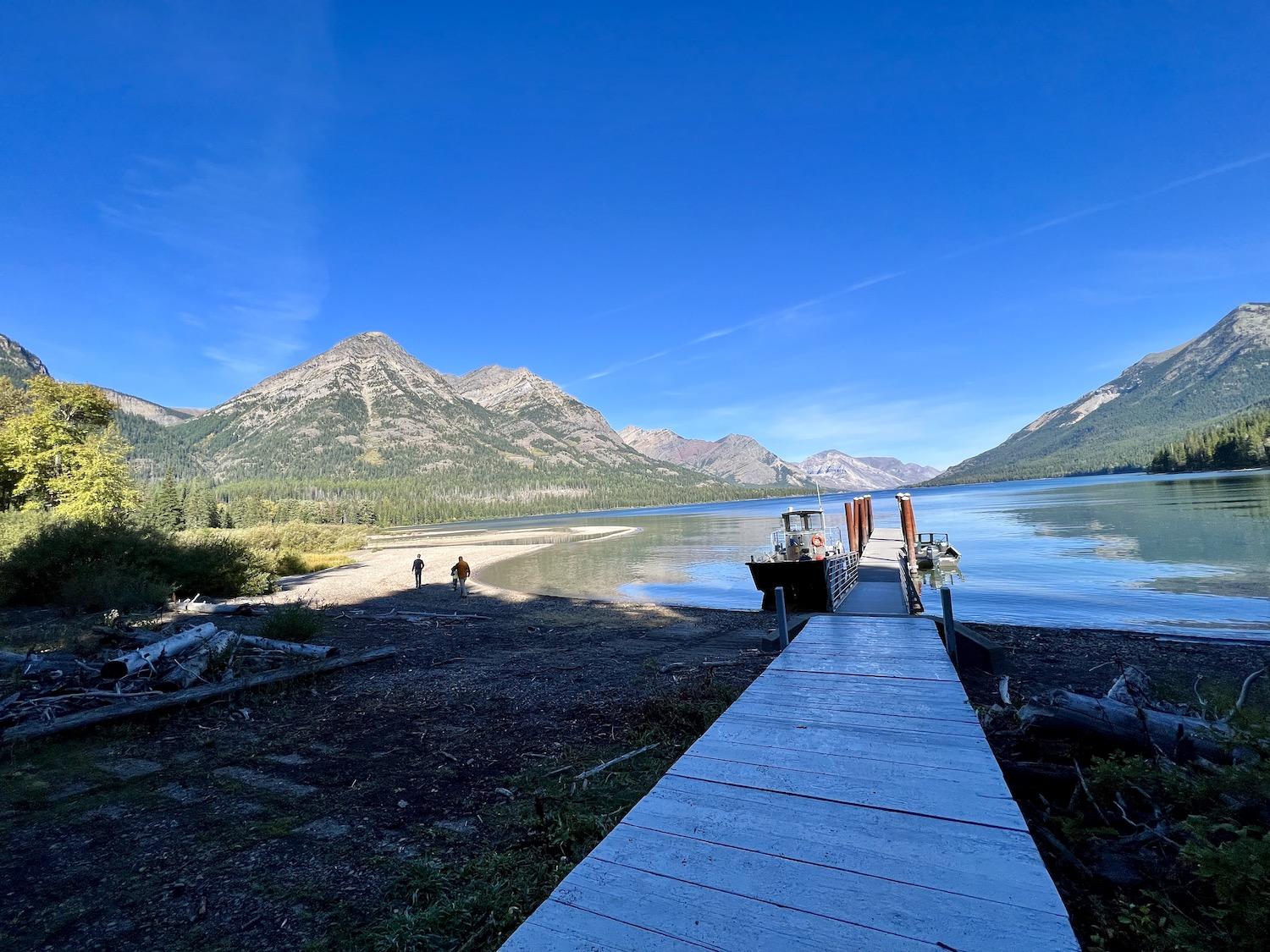
From Goat Haunt in Montana, you can look north along Upper Waterton Lake towards Alberta/Jennifer Bain
UNESCO agreed that these parks where the mountains meet the prairies, and where water flows to three oceans, are something special. In 1995, it blessed the area with yet another designation — Waterton-Glacier International Peace Park World Heritage Site.
“What will I do for peace?” a message board in the Peace Pavilion now asks visitors.
“Kindness is free,” reads one reply. “I want to spread it like wildfire and approach others with more kindness. We all have a story.”
“Be respectful of nature,” suggests another. “It just listens & lets you breathe.”
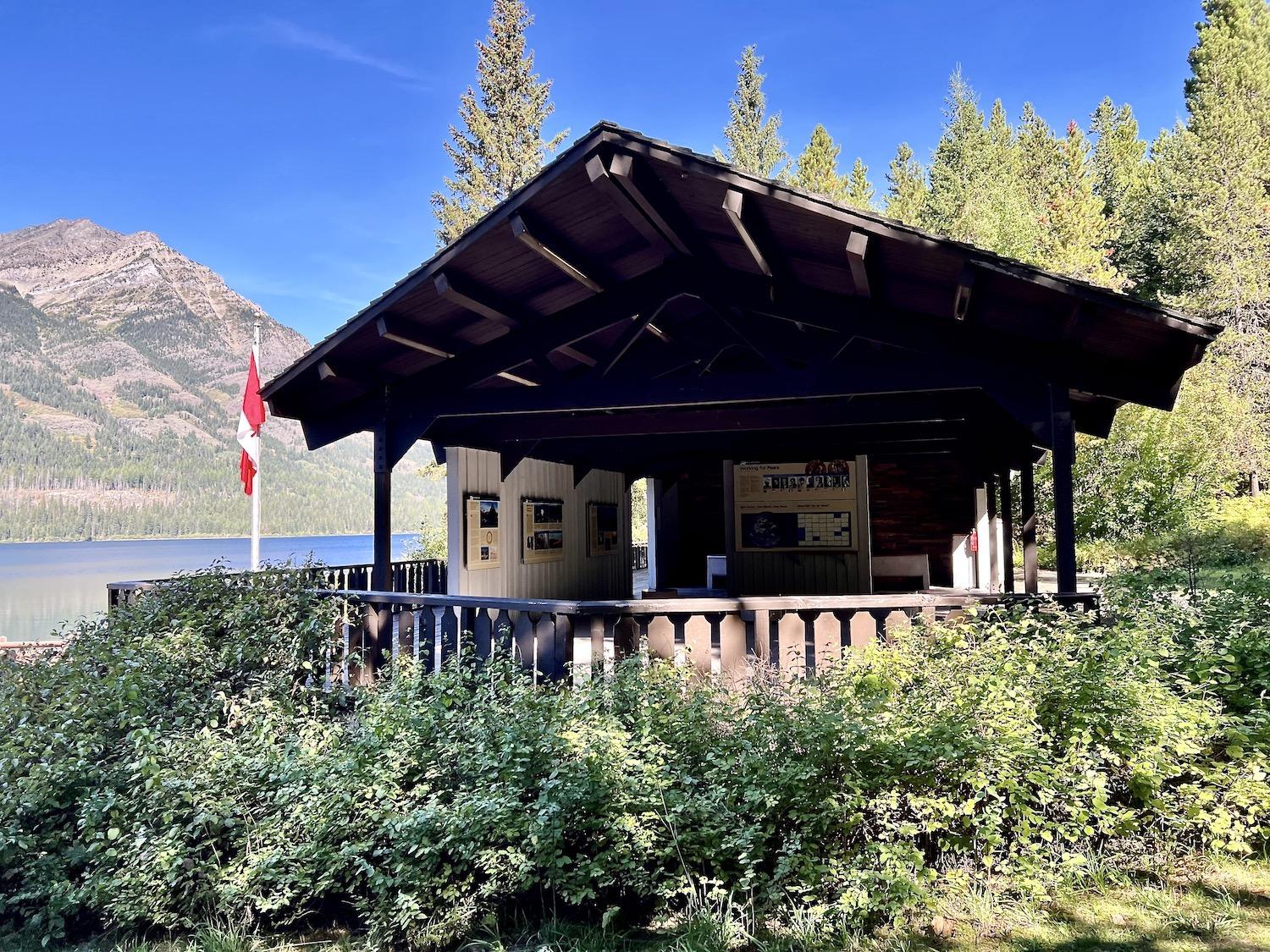
A small, open-air pavilion by the Goat Haunt boat landing has exhibits about peace and the creation of the Waterton-Glacier International Peace Park/Jennifer Bain
The world’s first peace park has matured into an example of successful cooperative management of a larger ecosystem shared by two countries. Glacier and Waterton staff regularly cooperate on things like wildlife management, fire management, search and rescue, educational programs, staff exchanges and threatened species conservation.
This is actually the first summer since 2018 that the Goat Haunt ranger station has been open. In 2019, the maintenance person who was also in charge of water was needed elsewhere. From 2020 to 2022, pandemic border restrictions kept it closed.
Up to eight NPS staff members live here at different times between April and October, overseeing maintenance, trails, law enforcement and interpretation. The boat trips that visit Goat Haunt, handled by the Waterton Shoreline Cruise Co., ran June 24 to Sept. 24 this year. (The company has a different boat that only cruises to the border to see the cutline running through the forest.)
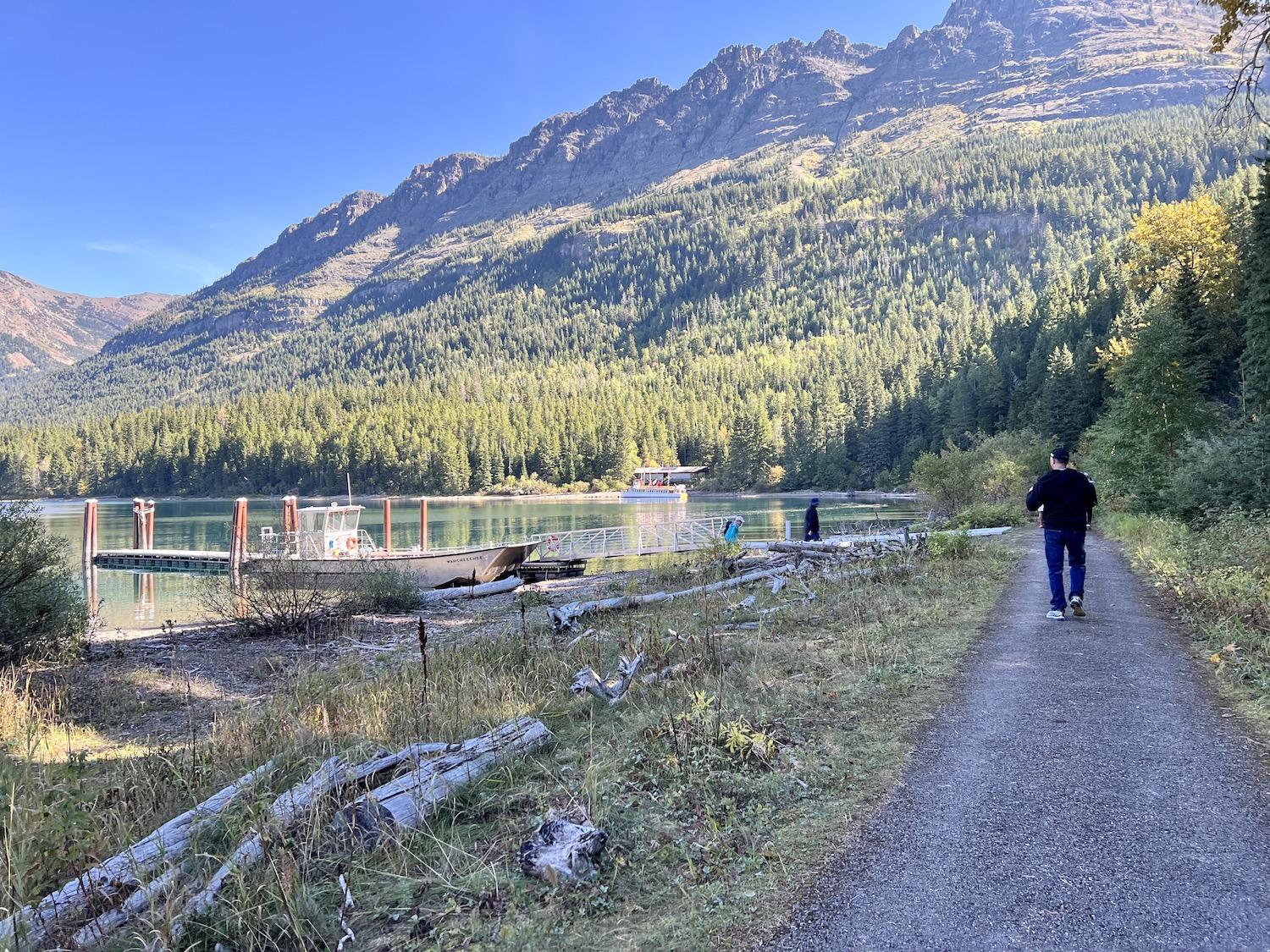
A paved pathway goes between the Goat Haunt boat landing and the ranger station/Jennifer Bain
“Go to any other popular place in this park on a beautiful day like this and you will be overwhelmed with hundreds, if not thousands, of people — and right now we have just a few dozen,” Jahn points out when I visit Sept. 15.
Not only does the ranger talk to us for 10 insight-packed minutes in Goat Haunt, he helps with narration on the way back to Waterton and then spends two hours outside the Canadian park’s visitor center, showing off pelts and animal bones and giving his “Grizzly Gastronomy” talk.
Glacier has a higher concentration of grizzly bears than Denali National Park & Preserve in Alaska, he tells us. From mid-summer to fall, some of these hungry bears climb the park’s highest mountains in search of army cutworm moths.
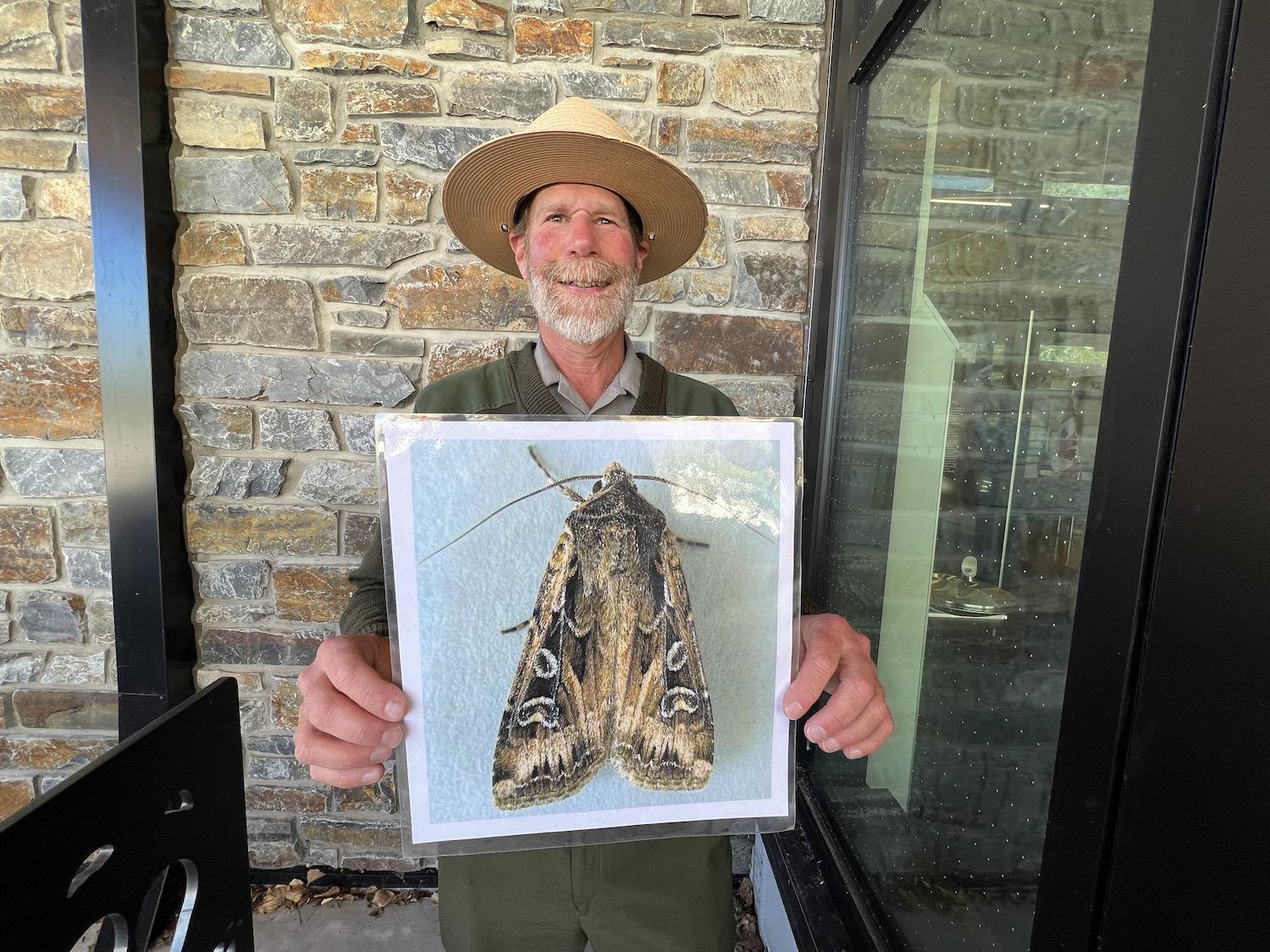
While at the Waterton Lakes National Park visitor center in Canada, Glacier National Park ranger Frank Jahn talks about how grizzlies feast on army cutworm moths in his Montana park/Jennifer Bain
These unusual moths hide from the heat beneath rocks and boulders by day, but collect the nectar of alpine wildflowers at night. By the end of the season, each moth will have about the same nutritional value as the same size piece of venison, Jahn says, and grizzlies know it’s easier to catch a moth than a deer.
The bears will “face up hill, spread their hind legs apart, take their front paws and begin scooping rocks and boulders down between their legs” until they find thousands of moths nestled together sleeping.
“Then all the bear has to do is open its mouth, stick out its tongue and lick them up,” the ranger explains. One grizzly can eat 40,000 moths a day. That works out to 20,000 calories or about 40 Big Macs.
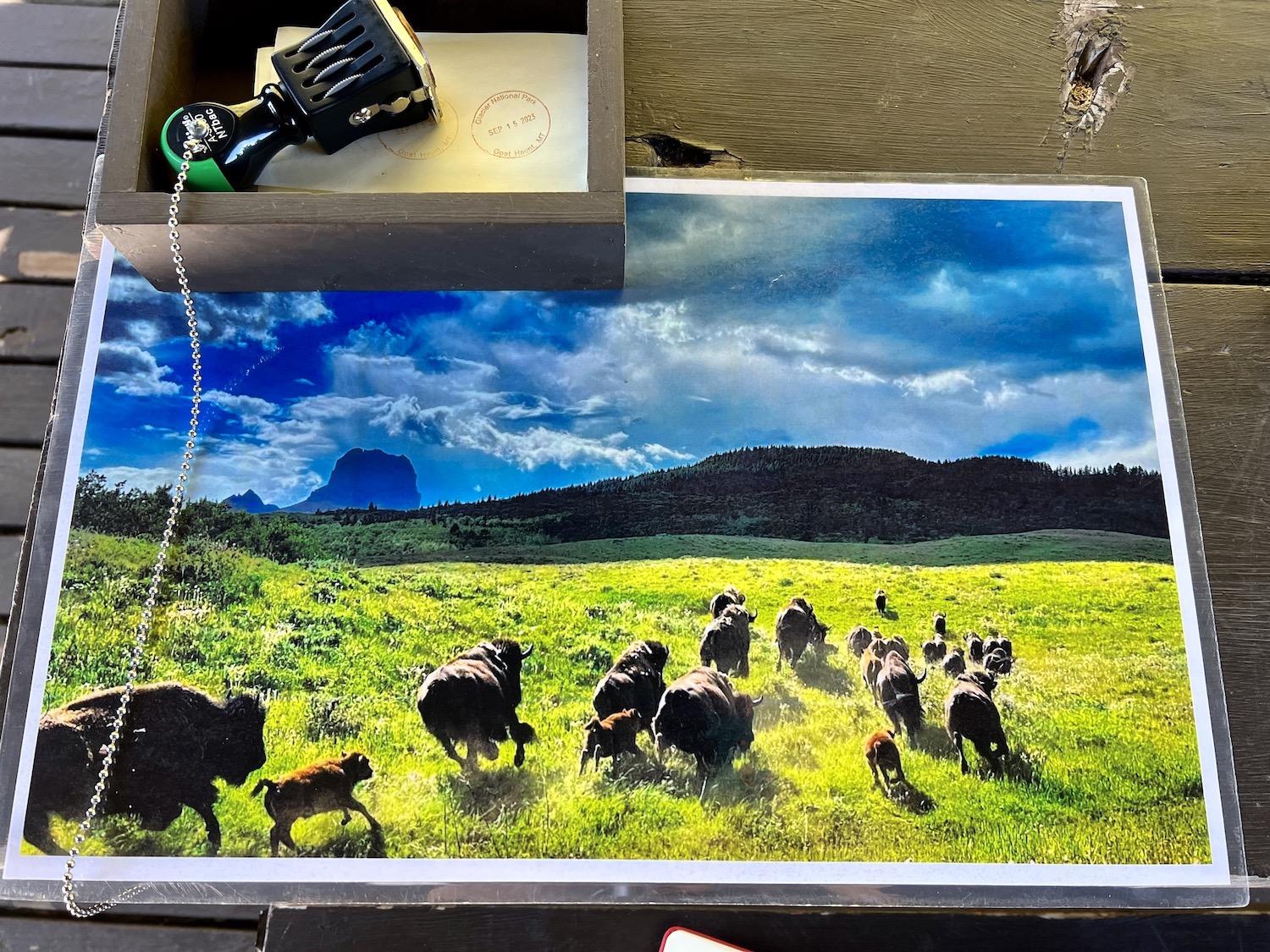
Free-roaming bison recently released by the Blackfeet Nation in Montana may wind up in Glacier National Park. Glacier's Goat Haunt park stamp is shown behind the laminated bison photo/Jennifer Bain
Jahn is also eager to share that Glacier is unique because it could now be home to America’s newest free-roaming herd of bison. Bison have been absent from the park for 150 years, but the Blackfoot people of Alberta and Blackfeet people of Montana have started reintroducing them to the ecosystem.
In June, the Blackfeet Nation released more than two dozen bison into the wilderness adjacent to Glacier, and the NPS agreed to let the animals roam into the park. These genetically pure bison, from Elk Island National Park in Alberta, are the direct descendants of some of the last bison to freely roam this land.
We don't luck into seeing bison, nor do we see mountain goats, but we do talk about Goat Haunt's curious name.
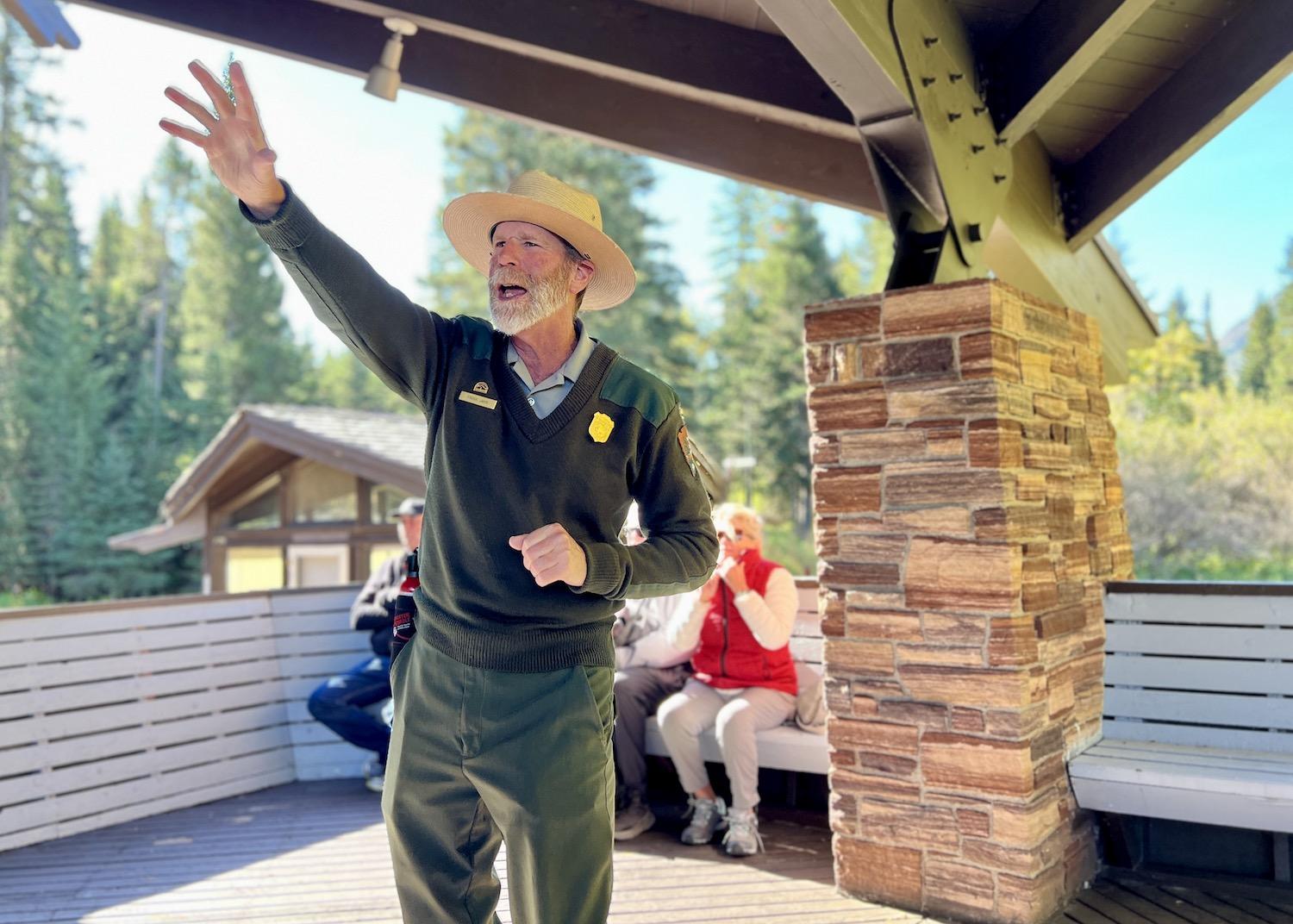
NPS ranger Frank Jahn gives an animated but brief talk at Goat Haunt's Snowflake Pavilion to guests from the M.V. International/Jennifer Bain
“No, this place isn’t haunted by goats,” laughs Jahn. “The word haunt in this context means a place frequented by something. So this would be a place where mountain goats hang out. And in fact, the Blackfeet name for this area, when literally translated into English, means `where there are a lot of goats.’ However, if you came here looking for a lot of goats you may leave just a little bit disappointed because for reasons we don’t fully understand, the goats don’t make as much of an appearance as they once did. Could be that the habitat has changed. Could be the fact that back in the late 19th and early 20th centuries, a lot of the goats were hunted out of this area and the population has not recovered.”
That said, standing on the dock the last few nights with binoculars, the ranger spotted several goats making their way across Goat Haunt Ridge, and so he urges us to watch for “tiny white specks” on our boat ride back to Canada.
For that ride, the ranger challenges us to cultivate a little peace of our own. The International was named to reflect the fact it travels between two countries, but it also holds an international array of passengers. Peace doesn’t begin with a peace park or with a treaty, Jahn points out, but “as people from different cultures and different countries get to know one another and begin to break down those barriers that separate us.”
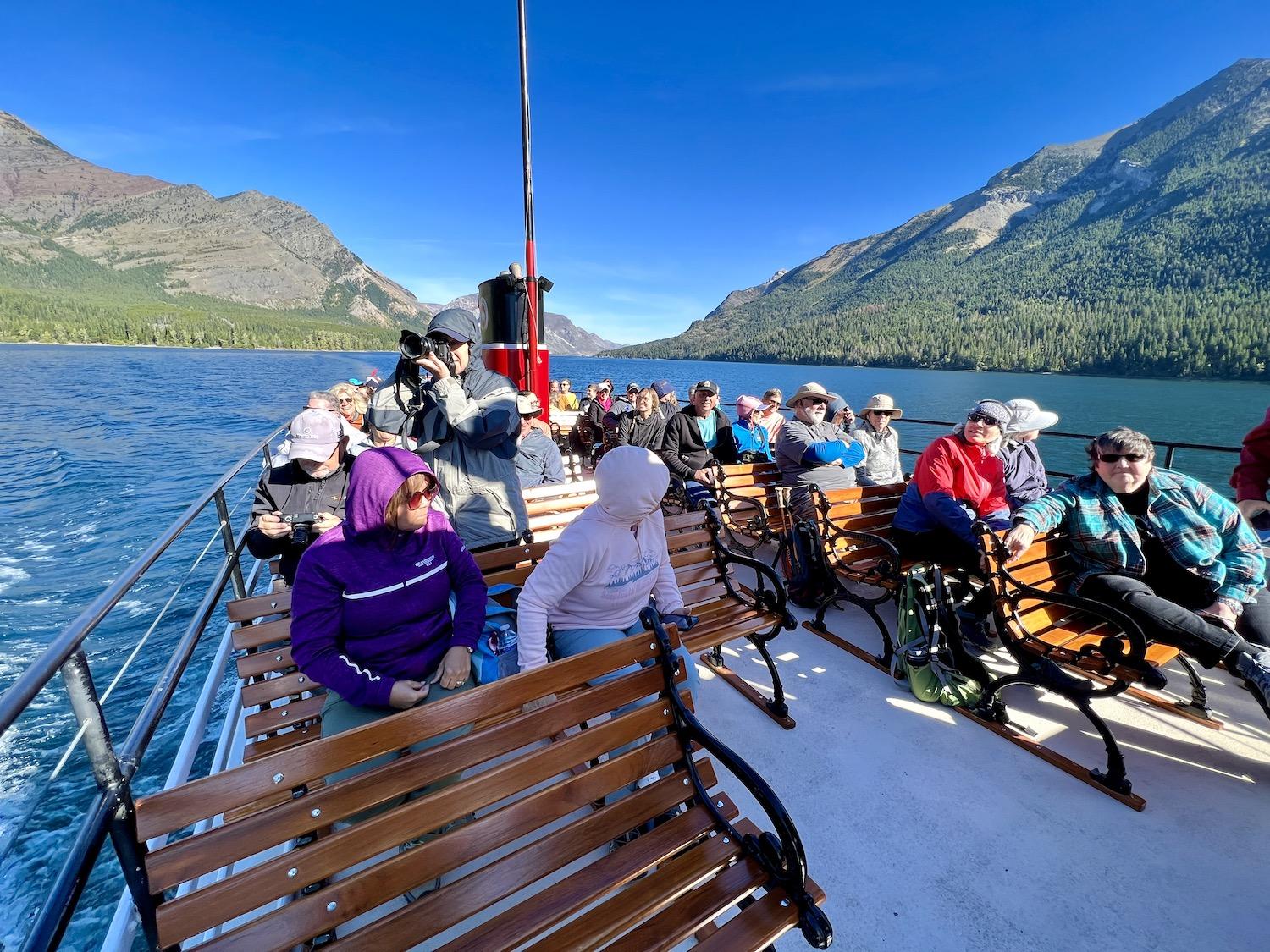
On Sept. 15, 2023, most of the several dozen guests aboard the M.V. International were American plus a few Canadians/Jennifer Bain
The International was built on Waterton Lake in 1927 and is the oldest operating passenger vessel in Canada. The historic wooden vessel, built of cedar and fir flanking on oak frames, now holds 165 passengers. It’s 73 feet long, 17 feet wide and was built specifically for this lake to take waves head-on like a canoe.
The wood was milled in Montana, taken by train to Alberta and then barged to Goat Haunt so the vessel could be assembled in the U.S. under protectionist rules set out by the Jones Act.
During the era of Alberta’s “Blue Laws,” when you couldn’t do things on Sundays like sell booze, the boat was used as a place for people to drink, dance and listen to music while technically in Montana. The vessel, now restored and operating as the flagship boat for Waterton Shoreline Cruise Co., is lovingly stored in a boathouse at Goat Haunt every winter.
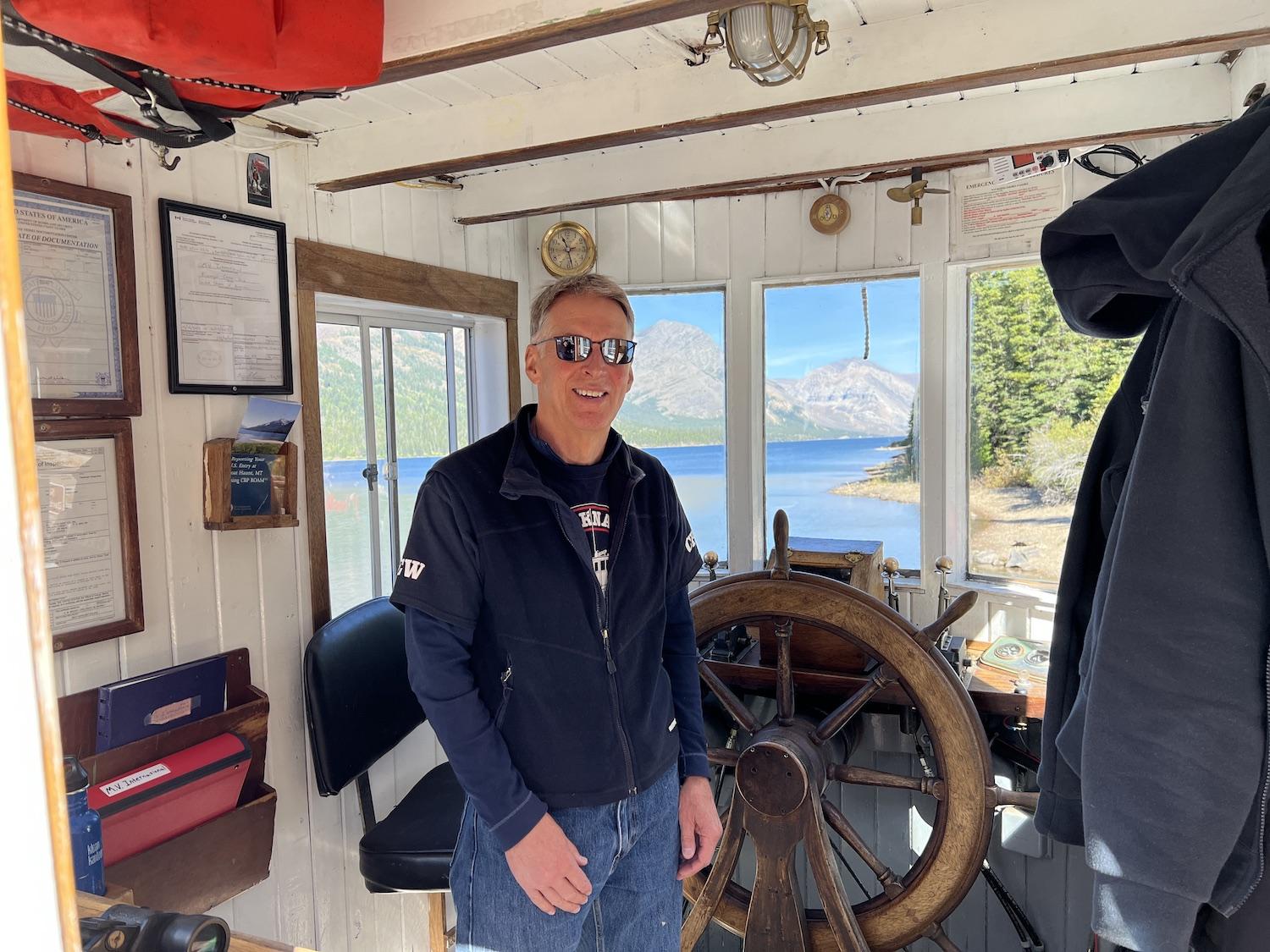
Phil Ruppel is the longtime captain of the M.V. International for the Waterton Shoreline Cruise Co./Jennifer Bain
It takes American Captain Phil Ruppel about 45 minutes to cruise from Waterton to Goat Haunt, a seven-mile journey along the deepest natural lake (487 feet) in the Canadian Rockies. Canadian tour guide Kevin Robinson regales us with stories about history, local characters, glaciers and the devastating 2017 Kenow Wildfire.
“It’s a pretty interesting way to enter the U.S,” allows Robinson.
A mountain goat logo — red, white and black — graces a funnel on the open upper deck of the International. It’s a nod to a goat named Rocky that graced the iconic logo of the Great Northern Railway, the American company that promoted tourism to Montana’s Rocky Mountain region and into Waterton, where it built the Prince of Wales Hotel.
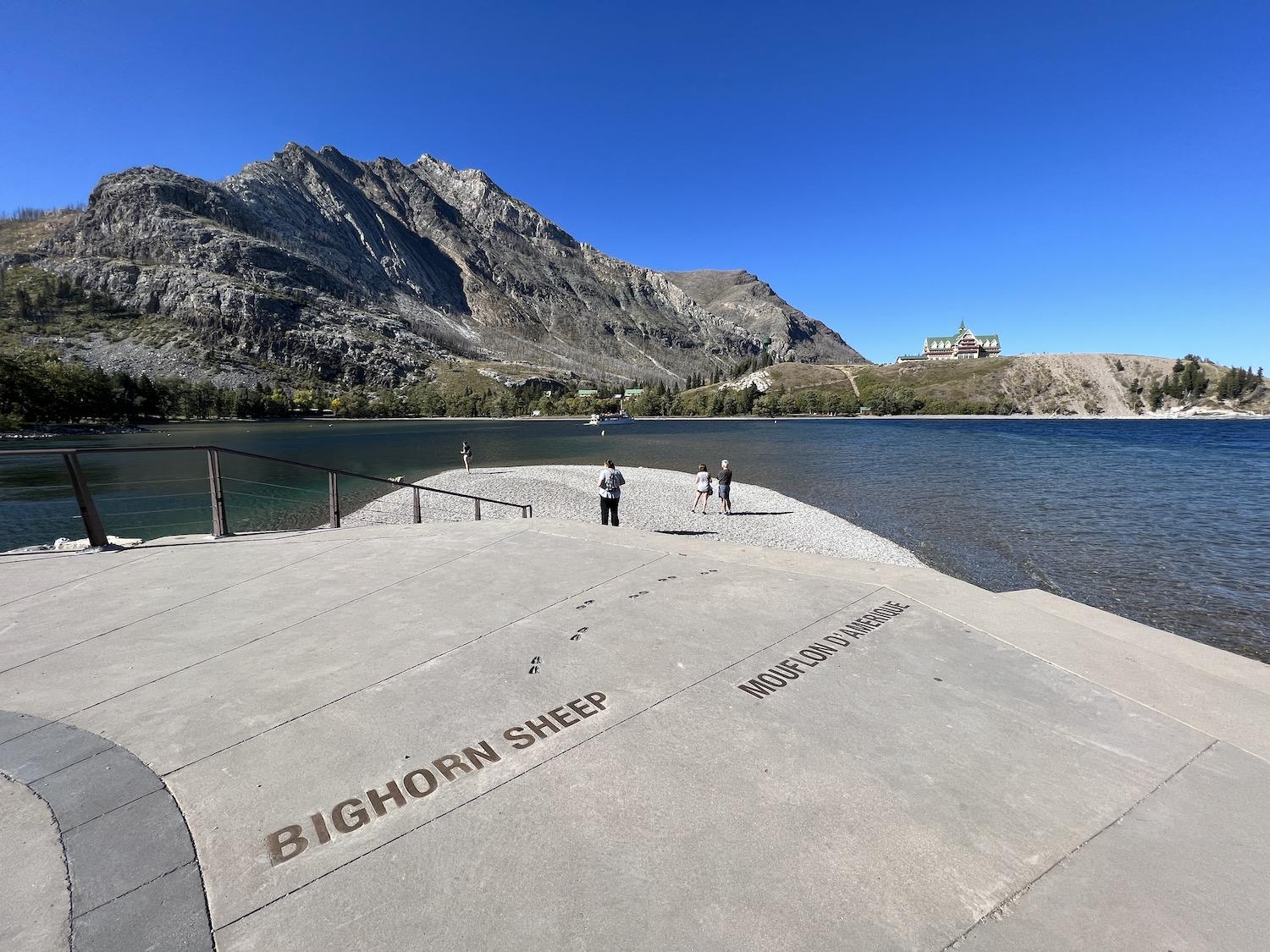
In Waterton, you can see the Prince of Wales Hotel from the waterfront Peace Plaza/Jennifer Bain
My Goat Haunt cruise runs like clockwork and last two hours and 15 minutes as promised. More importantly, it finally provides insight into what the peace park designation really means.
Jahn will finish his cross-border shift by spending two hours at the Parks Canada visitor center, showing off animal pelts and bones, talking about grizzly bears and moths, and promoting peace. But first he heads to his car — he keeps it here in Canada and uses it to get groceries — and then walks down to Waterton’s Peace Park Plaza to enjoy his lunch in the September sunshine.
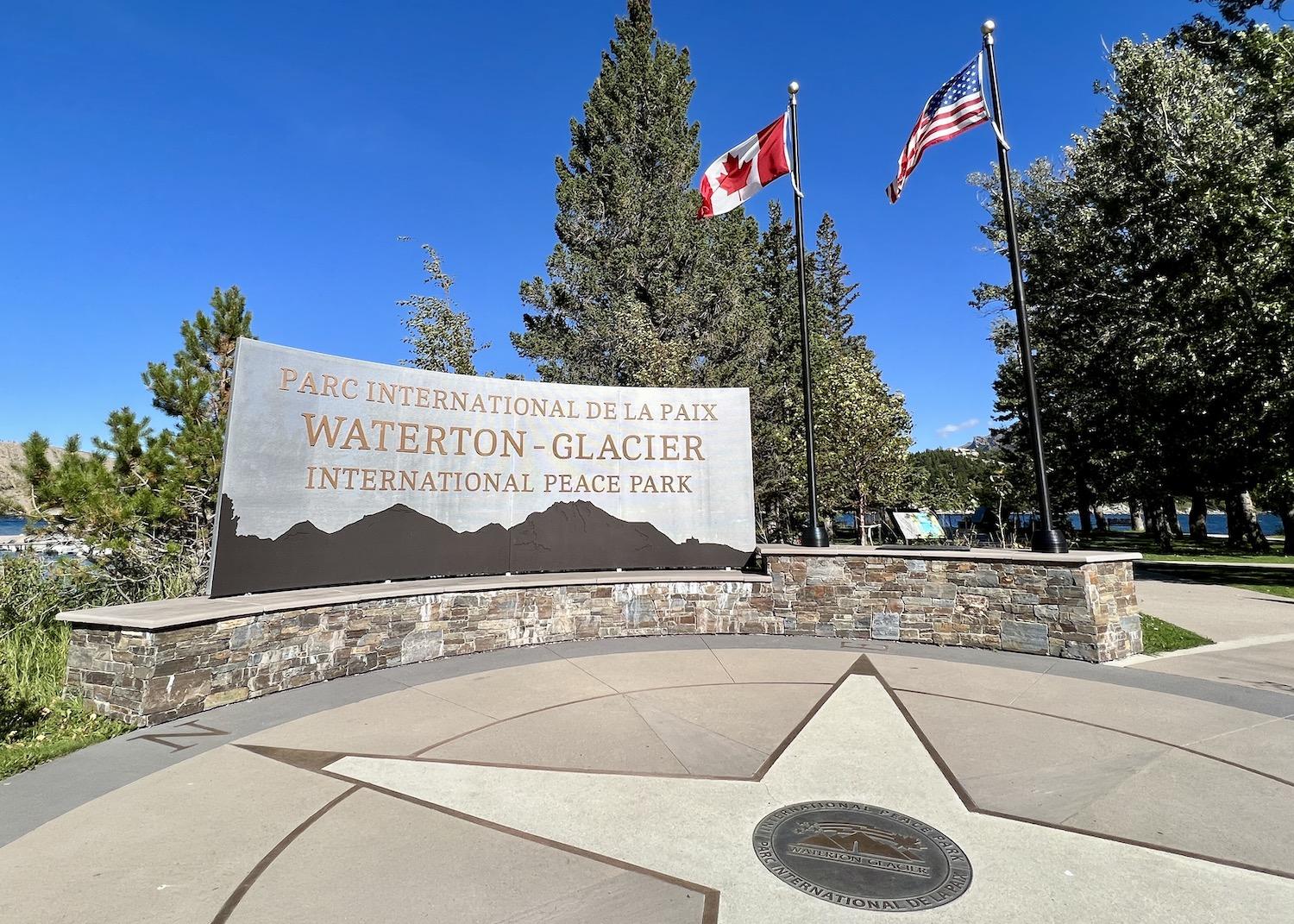
In Waterton's Peace Park Plaza, the Waterton-Glacier International Peace Park is marked by a grand entrance sign and a UNESCO World Heritage Site plaque/Jennifer Bain
This waterfront plaza provides another powerful setting to reflect on issues like peace.
Canadian and American flags fly beside a welcome sign and flank a UNESCO World Heritage Site plaque. Interpretive signs, spread out along the shore, lay out digestible tidbits about peace. Steps lead down to the lake, where you can see the International, kayaks and other boats as they go in and out of Emerald Bay.
There’s even a stone obelisk like the ones we saw from a distance at the international boundary in the woods. Since there isn’t anyone around to share a handshake with, I walk around the marker alone but smiling knowingly at the words “Canada” on the side facing north and “United States” on the side facing south.
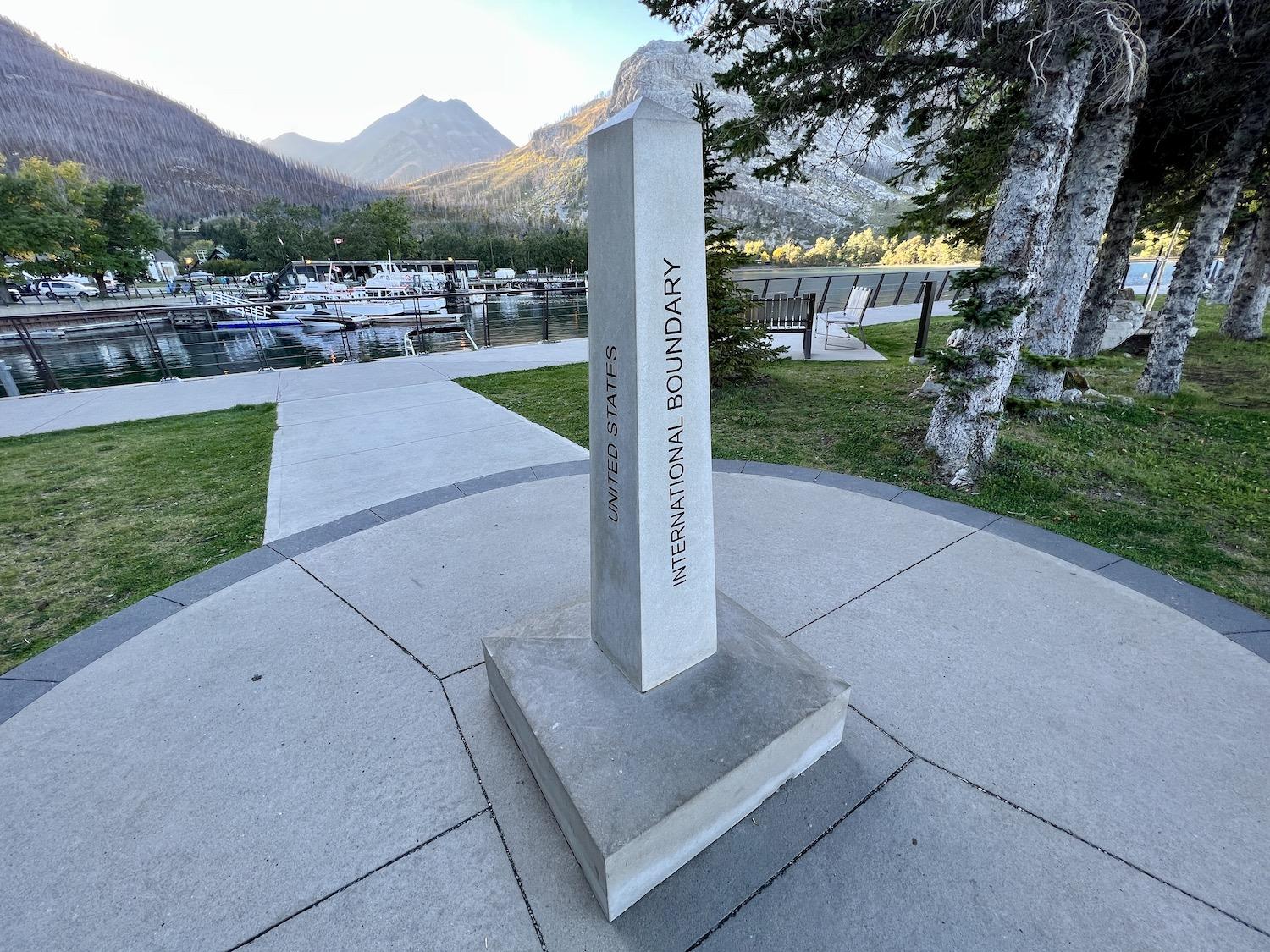
For those who don't hike to the real border in the wilderness, a ceremonial international boundary marker stands in Waterton's Peace Park Plaza/Jennifer Bain


